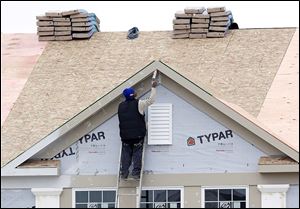
Fewer house flips, more buying projected in 2014
Obtaining credit may get easier, but mortgage rates likely to increase
1/12/2014
Experts say the pace in housing starts should heat up from 975,500 in 2013 to anywhere from 1.19 million to 1.25 million this year.
LOS ANGELES — Gabe Cole bought and sold 15 homes last year as part of his sideline as a house flipper.
This year, however, the Newport Beach, Calif., real estate broker anticipates his side business will slow down because foreclosures and short sales are drying up.
While 2013 was the year of get-in, get-out quick house flips, he expects to do more in-depth remodeling work on higher-priced properties in 2014. “Since there are fewer short sales and fewer foreclosures out there,” Mr. Cole said, “there’s less business to go around.”
Many economists agree. They predict 2014 will see more investors retrenching and more buyers putting roofs over their own heads.
That’s not the only big change ahead. Home prices are expected to stabilize this year, while homebuilding will be more frenetic.
“The housing market has staged a spectacular recovery over the past year,” Cal State Fullerton economists Anil Puri and Mira Farka wrote in their 2014 economic forecast. “More recent data, however, point to a softening of these trends.”
Here are the top real estate trends we’re likely to see in 2014.
● MORE INVENTORY: You can expect to see more people putting their homes up for sale this year, as rising prices bring new equity to underwater homeowners.
Other property owners also may take the opportunity to take advantage of higher home prices.
Donald and Stacy McCray are among them. Because of last year’s price gains, they say they believe now is the time to list their two-story Orange County, California, house so Mr. McCray, a railroad conductor, can move closer to work in Los Angeles. They plan to put their home up for sale later this month.
“I’m hoping that, since interest rates are still low, it’s a better opportunity not only to sell, but to rebuy,” Mr. McCray said.
Another factor: New home construction is expected to increase further this year, boosting options for home shoppers.
● NEW HOME SALES TO RISE: Nationwide, forecasters expect the number of housing starts to range from 1.19 million to 1.25 million, up from 975,500 in 2013.
Builders are compensating for years of subpar construction levels, said Robert Denk, an economist with the National Association of Home Builders. “There’s a huge construction deficit,” he said.
An increase in homebuilding means that new home sales should go up too.
When construction levels fell, “buyers were forced into resale homes,” said Irvine, Calif., housing consultant Mark Boud.
Many buyers prefer newer homes, which have the latest designs and are more energy-efficient.
● MORTGAGE RATES TO RISE: Interest rates for 30-year, fixed mortgages likely will rise this year, averaging somewhere in the 4.9 percent to 5.3 percent range, forecasters say.
That’s still low historically, but well above rates for the last 2½ years.
The average rate for a 30-year fixed mortgage had been below 4 percent since late 2011. Last summer, it spiked to 4.5 percent.
The Federal Reserve’s decision last month to start reducing purchases of Treasury and mortgage-backed bonds likely will push up mortgage rates. But not wildly.
“Rates are not going to soar because we’re still in a pretty weak economic recovery,” Mr. Denk said. “When the dust settles, [rates] are still a bargain.”
● CREDIT MIGHT GET EASIER: After years of tight lending standards, homeowners will have an easier time getting mortgages, said Svenja Gudell, director of economic research for housing Web site Zillow.
After last summer’s 1-percentage-point increase in mortgage rates, the refinancing business dried up for lenders.
“They want to fill that void with purchase money loans,” Ms. Gudell said. That may mean lenders may approve loans to borrowers with lower credit scores or higher debt.
“So we’ll see a lot of people who couldn’t get a mortgage in 2013 able to get a mortgage in 2014,” she said.
Others, however, aren’t so sure.
As new federal lending standards take effect on Jan. 10, some borrowers will get more scrutiny and less money. The new rules will have little effect in most cases, Ms. Gudell said, because most loans meet the new standards.
But Chapman University economist Esmael Adibi said lenders will have more leeway with the loans they plan to hold in their portfolios.
Tougher standards still will apply for loans that financial institutions plan to sell to mortgage giants Fannie Mae and Freddie Mac or elsewhere on the “secondary” mortgage market.
“Banks are eager to boost their lending,” Mr. Adibi said. “However, rates and requirements depend on the type of financial institution [offering the mortgage].”
● COMMERCIAL RECOVERY REMAINS SLOW: Forecasters say vacancies will drop and rents will rise this year in office buildings, shopping centers, factories, and warehouses. More deals will get done and sale prices for buildings likely will go up.
Nonetheless, the rate of recovery is expected to stay at moderate levels for commercial real estate.
Commercial real estate recovery “tends to lag broader economic growth,” said Deloitte & Touche’s 2014 outlook.
Nationally, commercial rent increases are projected in the 2.2 percent to 2.5 percent range this year, according to the National Association of Realtors.